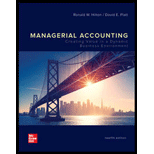
Borealis Manufacturing has just completed a major change in its quality control (QC) process. Previously, products had been reviewed by QC inspectors at the end of each major process, and the company’s 10 QC inspectors were charged as direct labor to the operation or job. In an effort to improve efficiency and quality, a computerized video QC system was purchased for $250,000. The system consists of a minicomputer, 15 video cameras, other peripheral hardware, and software. The new system uses cameras stationed by QC engineers at key points in the production process. Each times an operation changes or there is a new operation, the cameras are moved, and a new master picture is loaded into the computer by a QC engineer. The camera takes pictures of the units in process, and the computer compares them to the picture of a “good” unit. Any differences are sent to a QC engineer, who removes the bad units and discusses the flaws with the production supervisors. The new system has replaced the 10 QC inspectors with two QC engineers.
The operating costs of the new QC system, including the salaries of the QC engineers, have been included as factory

“Three hundred percent,” lamented the president. “How can we compete with such a high overhead rate?”
Required:
- 1. a.
Define “manufacturing overhead.” and cite three examples of typical costs that would be included in manufacturing overhead.
b. Explain why companies develop predetermined overhead rates.
- 2. Explain why the increase in the overhead rate should not have a negative financial impact on Borealis Manufacturing.
- 3. Explain how Borealis Manufacturing could change its overhead application system to eliminate confusion over product costs.
- 4. Discuss how an activity-based costing system might benefit Borealis Manufacturing.
Want to see the full answer?
Check out a sample textbook solution
Chapter 5 Solutions
Managerial Accounting: Creating Value in a Dynamic Business Environment
- Solve this financial accounting problemarrow_forwardFinancial Accounting Questionarrow_forwardA small retailer has the following transaction data: beginning inventory $8,400, purchases $64,000, purchase returns $2,500, freight-in $3,400, and ending inventory $11,000. Cost of goods sold is?arrow_forward
- On June 15, 2022, Dom Manufacturing had an employee, Daniel, who worked 5 hours on Job B-3 and 3.5 hours on general overhead activities. Daniel is paid $18 per hour. Overhead is applied based on $28 per direct labor hour. Additionally, on June 15, Job B-3 requisitioned and entered into production $275 of direct material. Daniel, while working on Job B-3, used $35 of an indirect material. Indirect material is included in the overhead application rate. Use this information to determine the total cost that should have been recorded in Work in Process for Job B-3 on June 15.arrow_forwardNueva Company reported the following pretax data for its first year of operations. Net sales 7,340 Cost of goods available for sale 5,790 Operating expenses 1,728 Effective tax rate 25% Ending inventories: If LIFO is elected 618 If FIFO is elected 798 What is Nueva's gross profit ratio if it elects FIFO?arrow_forwardAnswer thisarrow_forward
 Cornerstones of Cost Management (Cornerstones Ser...AccountingISBN:9781305970663Author:Don R. Hansen, Maryanne M. MowenPublisher:Cengage Learning
Cornerstones of Cost Management (Cornerstones Ser...AccountingISBN:9781305970663Author:Don R. Hansen, Maryanne M. MowenPublisher:Cengage Learning Managerial Accounting: The Cornerstone of Busines...AccountingISBN:9781337115773Author:Maryanne M. Mowen, Don R. Hansen, Dan L. HeitgerPublisher:Cengage Learning
Managerial Accounting: The Cornerstone of Busines...AccountingISBN:9781337115773Author:Maryanne M. Mowen, Don R. Hansen, Dan L. HeitgerPublisher:Cengage Learning

